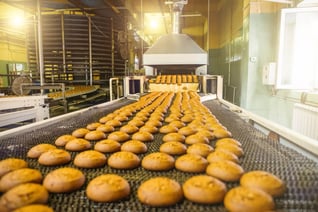With more advanced predictive maintenance tools at their disposal, today’s maintenance and operations teams can improve efficiencies and minimize unplanned downtime.
 Few other industrial environments can match the diverse and difficult operating conditions found across the food and beverage processing industries, which can have an adverse impact on the machinery used on the factory floor and also on overall productivity.
Few other industrial environments can match the diverse and difficult operating conditions found across the food and beverage processing industries, which can have an adverse impact on the machinery used on the factory floor and also on overall productivity.
With rising energy and labor costs, there is a need to optimize equipment reliability and to maximize uptimes so many operations are looking to maximize equipment output by extending the mean-time-between-failure and solving challenging application problems.
Reactive maintenance can be up to four times more expensive than planned maintenance, so many operations have moved to preventative maintenance strategies. Instead of carrying out repairs following a failure, regular checks and interventions are scheduled.
While technicians have traditionally depended largely on human senses to detect changes in temperature, vibration, lubricant condition, and other operating parameters, much greater sensitivity and accuracy is now possible – largely thanks to purpose-developed, hand-held measuring instruments which can be applied manually during routine walk-through inspections. For more sophisticated monitoring, sensors can be permanently installed on the machinery to gather data automatically and transmit it across a network.

It is becoming cheaper and easier to connect these data-gathering sensors and this has substantially reduced the installation labor, cabling and communications hardware expenses which account for as much as three-quarters of a system’s total cost.
One chocolate manufacturer has benefitted from the predictive maintenance and the use of sensor data. Producing 250,000 tons of chocolate, the plants original preventive maintenance program was time-consuming and involved more than 2,000 inspection points with up to 500 being measured at a time. An equal number of hours was spent recording the data collected.
An operator-driven reliability process was used to maximize the front-line maintenance contribution. Monitoring points were established and suitable data collection routes were compiled. Within a year, this automatic data collection process helped save one man-day per week and achieved greater organizational flexibility because inspections could be performed by a wider number of employees. In addition, production losses were reduced by 1%, while product quality was increased.
Increasing OEE and Efficiency
 Improving overall equipment effectiveness (OEE) is always a challenge. One solution is to transition from a time-based maintenance approach to a condition-based one. A review of all maintenance activities provides a better understanding of what maintenance practices are carried out effectively, and where there is room for improvement. This information is then used as the basis for diagnosing the source of the problem, with the objective of applying the necessary technology to eliminate reoccurrence to achieve an extension of machine life.
Improving overall equipment effectiveness (OEE) is always a challenge. One solution is to transition from a time-based maintenance approach to a condition-based one. A review of all maintenance activities provides a better understanding of what maintenance practices are carried out effectively, and where there is room for improvement. This information is then used as the basis for diagnosing the source of the problem, with the objective of applying the necessary technology to eliminate reoccurrence to achieve an extension of machine life.
An example of this can be seen at a noodle plant that was experiencing poor availability due to unexpected machine failures. To improve the overall efficiency of the plant, the organization decided to pilot a study on one of their noodle lines to better understand the origin of the problems.
The approach involved a detailed survey of the noodle line, including the collection of data regarding bearings, transmission products, power consumption details and operating environments, including maintenance histories. A review with engineers and a collection of drawings was also included. A baseline of existing lubrication practices and lubricants was established and finally, the current condition of the line was captured through condition monitoring – this enabled the detection of any misalignment, unbalance, bearing defects and structural looseness issues.
 The findings of the survey were evaluated and a set of corrective actions established. The survey proved the potential benefits of a condition-based maintenance approach as a number of issues were immediately identified such as oil leakages; chain breakages; seal, bearing, belt and gear failures. Remedial activities were subsequently carried out, including the laser alignment of belts and couplings, balancing, a changeover from manual to automatic lubrication and a lubrication systems upgrade.
The findings of the survey were evaluated and a set of corrective actions established. The survey proved the potential benefits of a condition-based maintenance approach as a number of issues were immediately identified such as oil leakages; chain breakages; seal, bearing, belt and gear failures. Remedial activities were subsequently carried out, including the laser alignment of belts and couplings, balancing, a changeover from manual to automatic lubrication and a lubrication systems upgrade.
It also included the upgrade of power transmission systems and additional recommendations were suggested to further develop a condition-based maintenance program that supported OEE enhancement. The end result was a better run, more efficient noodle line that could be replicated across the plant.
View the original article and related content on Control Engineering
https://www.controleng.com/articles/improving-machine-performance-and-reliability-with-predictive-maintenance/









